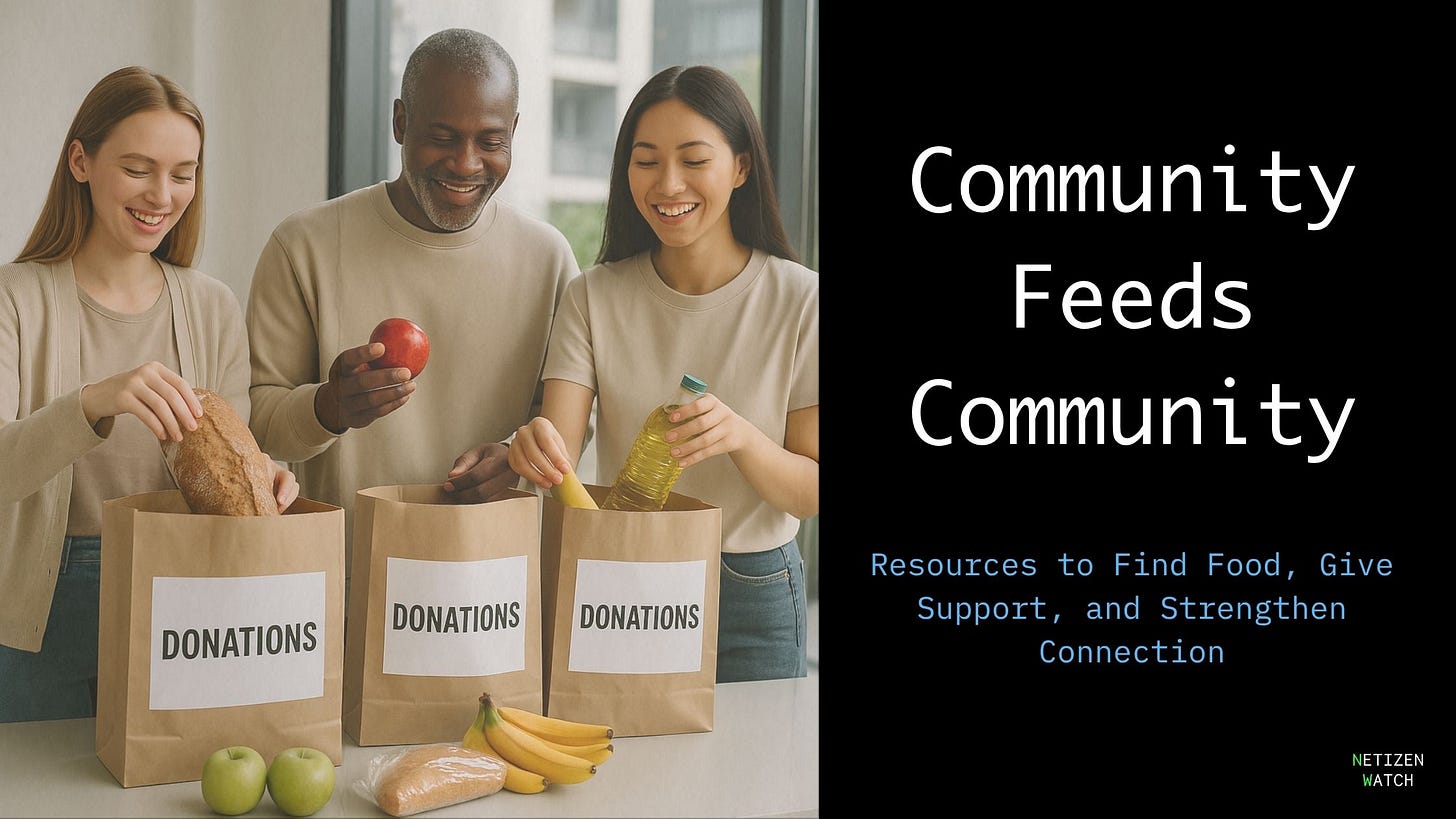Supporting Your Table
How to find Donation Centers & Community Support
Let’s make sure no table is left unfilled.
With early November here, many families face the possibility of benefit delays or gaps. If you’re dealing with this yourself or know someone who might be, having a support map now matters.
This post stays away from politics. Instead, it’s all about actionable, accessible help, where to find food, how to give help, and how to keep your household (or someone else’s) covered.
Why having a “backup” food-resource list matters
When food access is uncertain, everything else (focus, strength, emotional space) gets narrower.
Knowing where to go ahead of time means less stress in the moment.
When you help others, you build resilience in your community (and in yourself).
Where to Find Food-Donation Centers & Support (National + Regional Links)
National Tools:
Feeding America — “Find Your Local Food Bank” tool: enter ZIP code/state to locate food banks and partner agencies.
FoodPantries.org — Directory of food pantries by state in the U.S.
FoodFinder — Map search for food pantries/assistance programs across the U.S.
United States Department of Agriculture (USDA) TEFAP Program — emergency food assistance at the state level.
Regional Breakdown (by major U.S. region):
West & Pacific
Food Lifeline (Washington State) — map of food banks & resources.
Midwest & Plains
Harvesters — The Community Food Network (Kansas City / Topeka region) — locator for pantries/drive-thru pick-ups.
Northeast
Food Bank for New York City — map of nearly 800 pantries, mobile food sites, plus SNAP support in NYC.
South & Southeast
Food Bank of Central & Eastern North Carolina — a network of pantries and meal sites for the region.
How to Use These Resources (Step-by-Step)
Enter your ZIP code in one of the directories above.
Check hours, requirements, and whether you need to call ahead.
Bring reusable bags or a box if you’re picking up.
Save 2-3 locations near you (in your phone or notebook).
Share this list or resource link with someone in your circle who might need it.
Supporting Others: Simple Ways to Help
Donate non-perishables or funds to a local food bank.
Volunteer time (sorting, distributing, and delivery).
Share this post or the resource links with your network.
If you’re able, adopt a “give-ahead” mindset: surplus today may support someone tomorrow.
🌍 A Note on Dignity, Food Security & Connection
Food insecurity doesn’t have a single face or story. It can affect students, parents, veterans, working professionals, and seniors alike. It’s not a sign of your failure; it’s a reflection of how interconnected our lives really are.
When one person struggles to put food on the table, it ripples outward, into families, classrooms, workplaces, and neighborhoods. When that same person is supported, those ripples shift toward stability and hope.
Access to food is foundational to everything else: focus, wellness, learning, and community participation.
Food support is about more than filling a pantry; it’s about securing our collective well-being. Every meal shared, every donation, every volunteer hour is a quiet act of protection, a way of saying “you’re not alone.”
Today’s food banks, community markets, and mobile pantries are designed to provide choice, respect, and humanity because nourishment should never come at the cost of dignity. They’re becoming ecosystems of care, connecting people with fresh produce, job resources, health education, and stability that lasts beyond a single meal.
Food security is connection.
It’s the comfort of knowing your neighbor has enough. It’s the quiet assurance that someone would do the same for you.
By helping one another stay food-secure, through sharing resources, volunteering, donating, or simply spreading awareness, we strengthen the collective infrastructure that keeps communities thriving.
Food is not just fuel; it’s connection, dignity, and shared responsibility.
Quick Checklist for Your Table
Find 1-3 food-assistance locations and save their info.
Check for upcoming distribution dates and times.
If you can donate this week, pick 5 good shelf-stable items (beans, peanut butter, shelf-stable milk, whole-grain pasta, formula, if needed).
Share resource links with a friend, neighbor, or someone in your network.
Why This Matters
Food insecurity doesn’t have a single face or story. It can affect students, parents, veterans, working professionals, and seniors alike. It’s not a sign of your failure; it’s a reflection of how interconnected our lives really are.
When one person struggles to put food on the table, it ripples outward, into families, classrooms, workplaces, and neighborhoods. When that same person is supported, those ripples shift toward stability and hope.
Access to food is foundational to everything else: focus, wellness, learning, and community participation.
A nourished person can think clearly, show up fully, and build with others.
By helping one another stay food-secure, whether through sharing resources, volunteering, or simply spreading awareness, we’re strengthening the collective infrastructure that keeps communities thriving.
Food is not just fuel; it’s connection, dignity, and shared responsibility.
Closing & Call to Action
No one should feel alone when the table shakes a little.
Today’s step: Enter your ZIP into one of the national or local locators above, jot down one pick-up location, and share the link with one person.
Together, we protect peace at the table.




